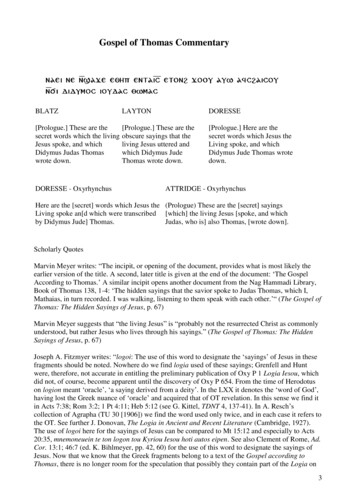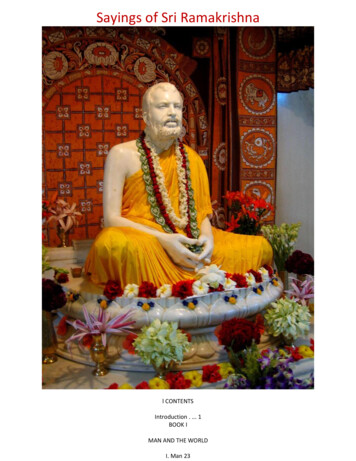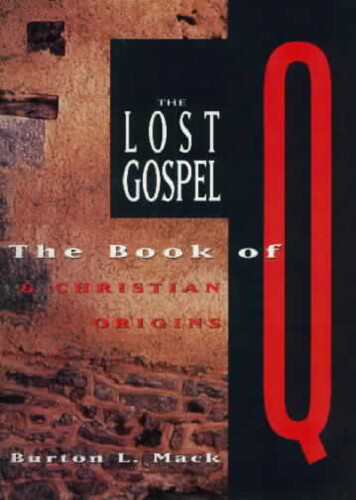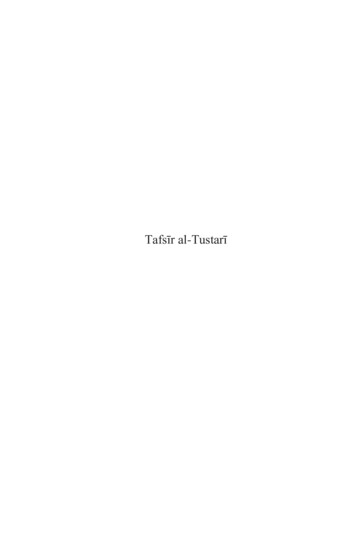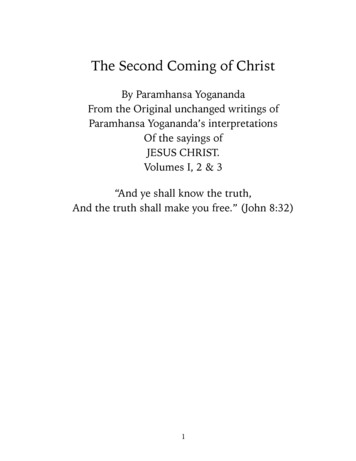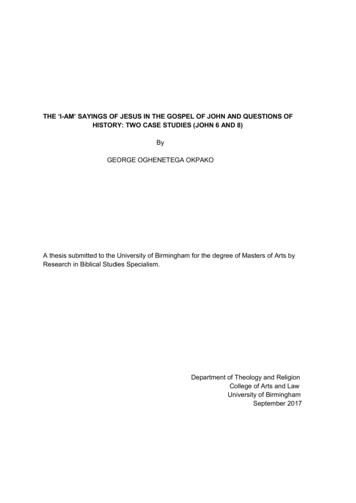
Transcription
THE ‘I-AM’ SAYINGS OF JESUS IN THE GOSPEL OF JOHN AND QUESTIONS OFHISTORY: TWO CASE STUDIES (JOHN 6 AND 8)ByGEORGE OGHENETEGA OKPAKOA thesis submitted to the University of Birmingham for the degree of Masters of Arts byResearch in Biblical Studies Specialism.Department of Theology and ReligionCollege of Arts and LawUniversity of BirminghamSeptember 2017
University of Birmingham Research Archivee-theses repositoryThis unpublished thesis/dissertation is copyright of the author and/or thirdparties. The intellectual property rights of the author or third parties in respectof this work are as defined by The Copyright Designs and Patents Act 1988 oras modified by any successor legislation.Any use made of information contained in this thesis/dissertation must be inaccordance with that legislation and must be properly acknowledged. Furtherdistribution or reproduction in any format is prohibited without the permissionof the copyright holder.
ABSTRACTTraditionally, reconstructions of the historical Jesus have been focused on the SynopticGospels. The Gospel of John has oftentimes been marginalised due to its high theologicalnature, despite containing Jesus’ ‘I-AM’ sayings which are expressive of his identity. Theresearch focuses on the question - Is there any possibility that the identity of Jesus could beexplored historically through the lens of the ‘I-AM’ sayings of Jesus in the Gospel of John?The research examines various scholars that have critically considered the issues such asthe ‘John, Jesus and History’ group and commentary authors.Most of the scholars I have investigated who supported aspects of historicity in the Gospel ofJohn, limited it to the traditions behind and elements in the settings of the ‘I-AM’ sayings inthe Johannine Gospel. I conclude that the ‘I-AM’ sayings of Jesus in the Gospel of John arerelevant in considering the identity of the historical Jesus, despite the difficulty of verifyingthem with historical facts. Recommendations are made that more work needs to be done bybiblical scholars in looking historically into the Gospel of John and considering the ‘I-AM’sayings of Jesus in the Gospel of John in further historical research.
ACKNOWLEDGEMENTSI want to thank God for His awesome plans concerning my life and in particular, the privilegeof leaving Nigeria to do my Master’s program in the University of Birmingham, England,United Kingdom.I thank my primary supervisor Dr Karen Wenell from the department of Theology andReligion, College of Arts and Law, Biblical studies specialism. Karen has given meenormous supervision and support throughout the Master's program, and has helped meestablish a better understanding of academic writing and grounding in the critical - historicalapproach of the thesis.I would also like to appreciate the contribution of my secondary supervisor, Dr IsabelWollaston from the department of Theology and Religion, Holocaust studies andcontemporary Christian - Jewish relations. Isabel helped me gain a broader perspective ofthe thesis and establish a cautious footing regarding the Jewish passages.I would also like to thank Mr. Sunday O. Odogun, Mr. Vincent O. Isiakpere, Mr. Dein S.Inaibo and Late Mr. Michael Ogunsanyan for their encouragement and financial support inkick starting the actualization of this vision.Lastly, I would like to thank my parents - Mr. and Mrs. George O. Okpako; my sisters - Mrs.Ejiroghene Kagbare, Mrs. Oghenekevwe Ferife and Barrister Miss Oghenerukevwe Okpako;and my wife - Pastor Mrs Martha Okpako and son - Dunamis Oghenetega Jr. Okpako, fortheir enormous words of encouragement and sacrifice during the period of the Master’sprogram.
CONTENTIntroduction.1. Chapter One: Review of Scholarship1.1 The Gospel of John.1.1.1 Materials found in the Synoptic Gospels but not in the Gospel of John.1.1.2 Materials found in John's Gospel but not in the Synoptic Gospels1.1.3 The Gospel of John marginalization from Jesus studies.1.1.4 Background to Johannine Studies / Historical Jesus.1.2 The ‘I-AM’ sayings in the Gospel of John.1.2.1 Background to the phrase ego eimi ‘I-AM’1.2.2 Use in the Synoptic Gospels.1.2.3 Distinct use in the Gospel of John1.3 Some of the problems of the ‘I-AM’ and reasons for focusing on John 6 and 81.3.1 Johannine predicative ‘I-AM’ omissions in the Synoptic.1.3.2 The Johannine Jesus speaks and acts in the mode of the evangelist1.3.3 Why an exegesis of John 6 and 8?1.4 Survey of selected commentaries1.4.1 Why an attempt to do a survey of Brown and Witherington?1.4.2 What is the approach of Brown and Witherington commentaries?1.4.3 What is their approach to the I-AM sayings of Jesus in the Gospel of John?133779101415171822222325262728302. Chapter two: An exegetical investigation of the ‘I-AM’ sayings of Jesus in John 6.332.1 Introduction-placement of the text and overall re-articulation of the research questions.332.2 Exegetical investigation of the key verses in John 6:22-59.342.2.1 The Jewish feasts - Passover feast in particular.382.2.2 The demand for a sign.402.2.3 The 'work' required from the multitude.422.2.4 The comparison between the 'manna' and 'bread of life'432.2.5 The audience of Jesus changed to the 'Jews'472.2.6 The Eucharist?482.3 Drawing out the Christological significance of the 'I-am' sayings in John 6.512.3.1 The Jewish feast512.3.2 The demand for a sign.522.3.3 The 'work' required from the multitude.542.3.4 The comparison between the 'manna' and 'the bread of life'552.3.5 The bread from heaven592.3.6 The Eucharist602.4 Drawing out historical aspects that are related to the text612.4.1 The Jewish feast - Passover in particular.612.4.2 The comparison between the 'manna' and the 'bread of life'662.5 Making connections and giving cautious conclusions about what these verses tell usabout the connection between the Jesus of History and the Christ of faith.683. Chapter three: An exegetical analysis of the ‘I-AM’ sayings of Jesus in John 83.1 Introduction3.2. Exegetical analysis of the key verses707070
3.2.1 Feast of Tabernacles723.2.2 Lawsuits between Jesus and the Pharisees - the authorities of the law743.2.3 The people called ‘the Jews’763.2.4 Sin763.2.5 Is the 'I-AM' a 'title' or 'representative'?773.2.6 Dualism.783.2.7 Anti-Judaism.793.2.8 Slave or freeborn?803.2.9 Abrahamic.843.2.10 Messiah.853.3 Drawing out the Christological significance of the 'I-am' sayings in John 8873.3.1 The 'Light' of the world873.3.2 The consequences of refusing Jesus as 'light'903.3.3 Jesus’ response to his opponents as the Light.943.2.4 The opponents as ‘the Jews’943.4 Drawing out historical aspects that are related to the text.963.4.1 Can the Gospel of John be a witness to the historical Jesus?971.4.6 What can be said to be historical in their interpretation of the Gospel of John, and inparticular in relation to the ‘I AM’ sayings?983.5 Making connections and giving cautious conclusions about what these verses tells usabout the connections between the Jesus of History and Christ of Faith.994 Chapter Four: Summary, Conclusion and Recommendation.4.1 Summary4.2 Conclusion4.3 Recommendation101101101103Bibliography104
INTRODUCTIONJesus Christ was one of the most prominent and popular men that had ever lived in thesurface of the earth. Although there was no book or material that can be ascribed to him asthe author, his fame and popularity had been evident from the countless numbers of booksand materials written about him, varying from different miraculous aspects of his life. Thesecountless numbers of books and materials written about Jesus have stemmed from the mostpopular claimed source - the Bible. And traditionally, most people have come to accept thatthe information provided about Jesus was credible. This attitude can be mostly seen fromthose who believe that Jesus was the Messiah and object of their faith - a belief which istermed Christianity. There is an emphasis in Christianity that the identity of Jesus could bederived from the sayings attributed to Jesus in the bible – among these, those referred to asthe ‘I-AM’ sayings of Jesus.The ‘I-AM’ sayings of Jesus can be seen in the Gospels of the New Testament. Mostdescriptions of Jesus' identities have been derived from the Synoptic Gospels. But the ‘I-AM’sayings of Jesus in the Gospel of John are presented by the author as purposeful wordsspoken by Jesus about his identity. The Johannine ‘I-AM’ sayings of Jesus have alsoreceived less acceptability due to their high theological nature. But in a more critical andlogical sense, could these sayings claiming information about Jesus in the Gospel of Johnbe considered from a historical point of view? This is the motivation behind this research, toattempt to look closely into the ‘I-AM’ sayings of Jesus in the Gospel of John in relation tothe identity of the historical Jesus, not to necessarily agree or object to already laid downpositions of biblical scholars on the issue, and not trying to produce any fact or evidencehistorically about the identity of Jesus but to explore the relevant arguments that have beenraised in this light.1
As such, a literature review of the Gospel of John; the ‘I-AM’ sayings of Jesus in theGospel of John; some of the problems of the ‘I-AM’ sayings identified by the 'John, Jesusand History’ research group; and survey of some commentaries may be relevant in fosteringthe understanding and exploration of the research. In addition, exegetical analysis of somepassages in the Gospel of John containing the ‘I-AM’ sayings of Jesus - John chapters 6 and8 in particular - will be undertaken to see if there is any relevant insight that could beconsidered to give a direction as to proffer any possible recommendation for the historicity ofthe identity of Jesus through the lens of the ‘I-AM’ sayings of Jesus in the Gospel of John.The research work is divided into four chapters. The first chapter sets out the issuesrelating to the Gospel of John and historical scholarship, and in particular to the ‘I-AM’statements / discourses in the Gospel of John. The second and third chapters will examinethe exegetical investigation on the ‘bread of life’ and ‘light of the world’ discourses in theGospel of John chapters 6 and 8 respectively. The exegetical investigation will draw out andsurvey the way that scholars and commentators have approached the Gospel of Johnchapters 6 and 8. Although, oftentimes, it seems that scholars and commentators on theGospel of John chapters 6 and 8 are interested in issues other than the questions raised bythe ‘John, Jesus and History’ research group about their significance for issues of Jesus andhistory; the research work will explore the Gospel of John chapters 6 and 8 for any possibleconnection to and relevance for Jesus and history. In regards to the third chapter - anexegetical investigation on the 'light of the world' discourse in the Gospel of John chapter 8, Iam aware that these verses have been considered by most scholars as anti - Jewish, but myintention is to use these verses to extrapolate and focus on 'Jesus as the light'. Finally, thefourth chapter concludes the study, highlights the main findings, suggests recommendationsand further research insights.2
CHAPTER ONEREVIEW OF SCHOLARSHIP1.1 The Gospel of JohnThe Gospel of John can be easily observed to be different from the Synoptic Gospels byjust merely reading through the New Testament. As such, current scholarships of the Gospelof John have tend to focus more on the unique conceptual world of its author or finalcompiler. The Gospel of John has been highly regarded as a religious writing due to itspurpose of imparting faith in the person of Jesus as the Christ, as the author or final compilerclearly states that - the record of Jesus’ signs in this book is to make whosoever that readsor hears about it, to believe in Jesus as the Christ and by believing, they will have life in hisname (John 20:30-31). Sloyan (1991:50) explained the Gospel of John in this way, ‘TheGospel of John tells the story of a man (Jesus) and what happened to him, what he did andwhat he said, whom he related to and how he ended - and will never end’.There are different issues that have been raised in the study of the Gospel of John. Thatis, there are a lot of theological contradictions in the Gospel of John. For instance, there existboth an elevated Christology (John 1:1) and subordination Christology (John 5:30); the signsterminology were both emphasized as a valuable means to evoke faith (John 20:31) and asa mere existential significance (John 20:29); Furthermore, there exists a present eschatology(John 5:24) and a future eschatology (John 6:54). But the issues I intend to engage with inthis research work is that, on the one hand, the Gospel of John has been denied historicityand has been concluded that it is not suitable for Jesus research because the distinctiveportrayal of Jesus it portrays is seen to be spiritual / theological. Scholarships that hasdocumented the dominance of the theological view of the Gospel of John include variousreference works, dictionaries of John and the Gospels, the Anchor Bible Dictionary andGerard Sloyan’s book - What are they saying about John? On the other hand, the Gospel of3
John has been critically examined for the relevance of its historical material. Scholarshipsthat supports a more strongly historical view are Dodd C. H. (1963) Historical tradition in thefourth Gospel. Cambridge: Antony Rowe Ltd; Anderson, P. 2007 ‘Prologue: Critical Views ofJohn, Jesus and History’. John, Jesus and History, Volume 1: Critical Appraisals of CriticalViews, 1-7; Bauchkam, R. 2009. ‘The Bethany Family in John 11-12: History or Fiction?’.John, Jesus and History, Volume 2: Aspects of Historicity in the Fourth Gospel, 185-202;Kostenberger, A. J., 1998. ‘Jesus as Rabbi in the Fourth Gospel’. Bulletin of BiblicalResearch Volume 8, 97-128.In reflecting on the problems of the Gospel of John, Ashton (1997:8) emphasized that thetheological and historical views of the Gospel of John are the two main groups that ‘mostacademic studies of the Gospel of John, irrespective of their range and diversity, may beconveniently grouped under’. Ashton further credited the genesis of both the theological andhistorical views of the Gospel of John to Bultmann’s two great riddles highlighted in hisclassic article published in 1925 but still untranslated in 1997 when Ashton was writing. Thefirst riddle was - where does the Gospel of John stand in relation to the development of earlyChristianity?, which Ashton referred to as history and the second riddle was- what is thecentral focus of the Gospel of John, its basic idea?, which Ashton reduced to theology. Theexplanation by Ashton on the problems of the Gospel of John supported the fact that thetheological/spiritual and historical perspectives of the Gospel of John is worth engaging inand also, these historical and theological perspectives might have some level of significancein exploring the various views of scholars on the identity of the historical Jesus.Recent scholarship about the Gospel of John that has been most relevant in criticallydiscussing the issues in the Johannine’s material is the work of the ‘John, Jesus and History’research group. ‘The ‘John, Jesus and History’ group is a forum of at least 350 scholars,who comes together annually to discuss issues relating to the historical background andcomposition history of the Johannine’s literature - the fourth Gospel and 1, 2, 3 John’(Thatcher 2007: 9-11). The ‘John, Jesus and History’ group started November 2002, they4
were granted Consultative status at the Society of Biblical Literature Annual meeting andwithin the first three years, they focused on topics relating to ‘the relationship between theJohannine’s literature and the study of the Historical Jesus. Especially preliminary issuesrelating to the study of the Gospel of John’s ‘historicity’, including ‘state of research’questions, discussions of the reasonable results of such an inquiry and methodologicalproblems’ (Thatcher 2007 :9-11). The ‘John, Jesus and History’ project are very muchinterested in the reasons why the Gospel of John has been interpreted as lacking historicalperspective or context, and they are attempting to investigate critically the issues that havebe raised in the denial of the Gospel of John a place in Jesus research. They are also tryingto suggest aspects of historicity in the Johannine’s material. The ‘John, Jesus and History’group discussions seem to have generated new insights on questions that are relevant bothto the interpretation of the Johannine literature and to the study of the life and teachings ofJesus. Although, the participants in (and the contributors to publications) of the ‘John, Jesusand History’ group reflect a wide range of theological and methodological background thatserves as the primary strength of their discussions, they are also united by three keypresuppositions:First, that all canonical Gospels (Matthew, Mark, Luke and John) are ‘spiritualGospels’ not only the Gospel of John because no early Christian was interested inJesus as a purely historical figure, despite the Gospel of John having a moretheological interest than the Synoptic. Secondly, that a serious reconsideration of thecontext of the Johannine literature is relevant to significant problems in Christianorigin. And thirdly, that any fresh attempt to explain the complex relationship betweenJohn, Jesus and history will require a substantial reconsideration, not only of theJohannine literature but also of the very meaning of the word ‘history’ and of currentmethods of studying the historical Jesus. (Thatcher 2007:9-12).The Gospel of John, on the one hand, contains events such as the advent of the eternalLogos and concluding with the ongoing ministry of the resurrected Jesus; hence, Anderson(2007:1) observed that although the Johannine perspective is cosmic, how could that reflectan earth-fettered historical perspective? And as such, he emphasized that ‘the prevalentscholarly opinion in the modern era has come to relegate the Johannine Gospel to thecanons of myth and theology rather than history; therefore the Gospel of John has become5
off-limits for historical quests for Jesus’. On the other hand, Anderson (2007:1-2) argued thatthe critical view of the non-historical Gospel of John creates new problems that cannot besolved by the mere relegation of the Gospel of John. Anderson proposes that:The Gospel of John has more archaeological content and topographical details thanall the other Gospels put together. The Gospel of John also bears many features ofhistorical realism that contributes a more plausible view of Jesus’ ministry than theMarkan Gospels. In addition, the Gospel of John possesses a great deal of mundaneand ‘theologically innocent’ materials that cannot be adequately explained on thebasis of the Gospel of John’s inferred ahistoricity. (Anderson 2007:2)Anderson (2007:37) explained that the distinction made by Clement which emphasizedthat the Synoptic wrote about the bodily aspect of Jesus’ ministry, while the Gospel of Johnwrote about the theological aspect of Jesus’ ministry, has provided a heuristic key of denyingthe historicity of the Johannine witness. The Clement of Alexandria’s late second centurycomment on the distinction of the Gospel of John - ‘but, last of all, John, perceiving that theexternal facts have been made plain in the Synoptic Gospels, been urged by his friends andinspired by the Holy Spirit, composed a spiritual Gospel’ (Eusebius 6.14) - was the mainreason why the difference between the Synoptic and the Gospel of John have been largelyascribed to as Synoptic ‘factuality’ versus Johannine ‘spirituality’. (Anderson 2007:37).Anderson (2007:38-43) argued that although the teachings and deeds of Jesus in theGospel of John are seen to have a very high spiritual inclination, Clement was not declaringthe Gospel of John to be historically inferior. Anderson explained that:The words translated ‘facts’ in Clement statement - ‘the Synoptic preserved facts incontrast to the Gospel of John’ - is actually somatika referring to the bodily aspect ofJesus’ ministry as contrasted to the spiritual perspective of John. In that case, it is amistake to interpret Clement as making a historical judgement about the Gospel ofJohn or the Synoptic. (Anderson 2007:38-39)This can be seen as a misunderstanding on the part of modern scholars (who followsEusebius’ evaluation). This is not a historically based judgement, but a mere supposedstatement as to how to make sense of the Gospel of John’s distinctively theological anddifferent presentation of the Jesus story. Anderson (2007:40-42) further supported hisargument that Clement was not a ‘modern positivist’. That Clement was merely declaring hisinference of the Synoptic Gospel’s tone and approach in contrast to the Gospel of John, not6
respective degrees of their historical reliability, nearly a century after the completion of thefour canonical Gospels.Some of the reasons raised that have denied the Gospel of John a place in the historicalJesus research will be examined.1.1.1 Materials found in the Synoptic Gospels but not in the Gospel of John:Rather than beginning with a birth narrative (Matthew and Luke), and Jesus’ ministeringfor only a year with the ‘cleansing’ of the temple at the end of his ministry in the SynopticGospels, the Gospel of John began with the eternal logos; three Passovers are mentioned inthe Gospel of John and the temple cleansing is at the beginning. Also the Gospel of Johndoes not include Jesus' teaching on the Kingdom of God; several aphoristic sayings; the endtime discourse (Olivet); the Sermon on the Mount - including the Lord's Prayer; an accountof Jesus' baptism; the institution of the Lord's Supper; transfiguration; Jesus' temptation bySatan; Gethsemane; and exorcism of demons.As a result, Anderson (2007:17) explained that the ‘Gospel of John’s ahistoricity seems tobe confirmed if one assumes a three (Synoptics) - against - one (Johannine) majority’. Buthe emphasized that ‘if Luke and Matthew used Mark, then viewing the Gospel of John’sdifference from the Synoptic Gospels as three - against - one minority must bereconsidered’. Anderson (2007:17) asserted that ‘if the Gospel of Mark got it wrong, so thenthe Gospels of Matthew and Luke. And he proposed that the Gospel of John and Mark needto be seen as a bi-optic Gospels’.1.1.2 Materials found in the Gospel of John but not in the Synoptic Gospels:Anderson (2007:24) emphasized that because events such as five of the Gospel ofJohn’s miracles (the wedding miracle, the healing of the official’s son, the healing of theJerusalem paralytic, the healing of the blind man and raising of Lazarus) and Jesus’dramatic dialogue with Nicodemus, the Samaritan woman, the Jewish leaders, Pilate andPeter in the Gospel of John are not recorded in the Synoptic Gospels; there is commonly inscholarship the conclusion that they were not known by the Synoptic writers and in general7
terms they cannot be accurate historical rendering. Other materials in the Gospel of John notfound in the Synoptic Gospels are teachings on eternal life rather than the Kingdom of God;extended discourses rather than aphoristic sayings; the farewell discourse (John 13-17);accounts of Jesus' interactions with John the Baptist, or of scenes in the upper room; Satanas Jesus' chief antagonists working through Judas Iscariot. Anderson (2007:25) has criticallyexamined the above reasons and emphasized that, ‘to argue that everything significantlysaid or done by Jesus would be included in the Synoptic, or even in all the Gospels record,is unsound’. Anderson submitted that the Gospel of John explicitly declared its intention inselecting these particular events (John 21:24-25), and the same was probably true of Markand the other Gospels.Reflecting on the differences of the materials found in the Synoptic Gospels and not inthe Gospel of John, and those found in Gospel of John and not in the Synoptic Gospels,there is a general explanation that the traditional way of accounting for these differences isthat the Gospel of John wrote to complement the Synoptic Gospels (Kostenberger 2013: 2223). This traditional way of accounting that the Gospel of John wrote to complement theSynoptic Gospels is in line with Clement Alexandria’s suggestion ‘John been conscious thatthe external facts had been set forth by the Synoptic Gospels , composed a spiritualGospel’. But in order for scholars to be more critical and logical in accounting for thesedifferences, there have been, more recently, the theory that the Gospel of John wroteindependently from the Synoptic Gospels.Kostenberger (2013:23) seemed to be in favour of the independence of the Gospel ofJohn. Kostenberger (2013:23) further explained that the independent view of the Gospel ofJohn does not mean that its author was unaware of the existence of the Synoptic Gospels orhad never read them, to remain unaware of or exposed to the Synoptic Gospels. If the viewof complete unawareness of the Johannine author is to be considered, it could only bemaintained when the Gospel of John is presented as a sectarian document entirely outsidethe mainstream of apostolic Christianity. Also, if the view that the Johannine author had8
never read the Synoptic Gospels is to be considered, it would raise further questions as tothe location of the Johannine author, especially there is the unanimous agreement that theJohannine author wrote later after the Synoptic Gospels. Kostenberger (2013:23) thyensuggested that the independent view of the Gospel of John means that its author did notmake extensive use of the Synoptic Gospel as he wrote or that he did not let his agenda beset by the Synoptic Gospels.Due to the fact that the Gospel of John contained traces of acquaintances with theSynoptic tradition, for instance John 1:40; 3:24; 4:44; 11:1-2, Kostenberger (2013:23) cameto this conclusion that 'the Gospel of John was almost certainly familiar with the Synoptictradition. but for whatever reason, the author of the Gospel of John saw it fit not to let theSynoptic traditions set his agenda. In this sense, John wrote independently'.1.1.3 The Gospel of John marginalization from Jesus studies:Due to the issue that the Gospel of John was finalised least among the canonicalGospels and it had been generally accepted to be dated around 100 C.E (e.g., Brown 1971:lxxx-lxxxvi; Lincoln 2005: 17-26); the Gospel of John’s claim to historicity is often rejectedbased on the conclusion that the earlier the traditional material of the Gospel, the greater theconfidence on its historicity. In this view, the Gospel of John’s Logos Christology combinedwith Jesus’ supremacy betrays a distanced and confessional reflection, and the Gospel ofJohn’s historical claim is rejected. But Anderson (2007:48-54) argued that the Gospel ofJohn’s late finalization is not a reliable basis for determining the Gospel of John’s historicity.Anderson (2007:66) concluded that the findings of the ‘John, Jesus and History’ group onthe Gospel of John, showed that neither the denial of the historicity of the Gospel of John northe denial of the Gospel of John a place in Jesus research was constructed on solidmaterials, so neither was able to support much weight for constructing the figure of Jesus.Anderson emphasized that the Gospel is constructed in response to real problems, as notany single one was compelling enough to be dominant. Some of the logic used in mostcases seem to be untrue and only part of the data are considered in most cases. Distortions9
of the Johannine and Synoptic materials sometimes appear to make an argument sturdier,but, when analysed critically, the facts and procedures themselves raise question with theanalyses and their conclusions.1.1.4 Background to Johannine Studies / Historical Jesus:Apart from the obvious observation that the Gospel of John has a different character tothe Synoptic Gospels and seems difficult at times to understand rationally by a lay reader ofthe New Testament, Johannine scholars such as Lindars (1971:11) have also affirmed thedifficulty of the Gospel of John as he writes: ‘The literature of the Gospel of John is soimmense, and even a scholar who devotes all his time to the study of the New Testamentcannot keep up with’. Johannine literature has experienced recent transition from the longstanding tradition that followed the dominant exegetical paradigm - ‘historical-critical’approach of interpretation, to a contemporary narrative approach as suggested byCulpepper in 1983.Moloney’s (2012:314) overview showed that Culpepper argued that ‘the Gospel of Johncould be read as a deliberately designed unified narrative utterance, with each single partdependent upon the whole’. The emphasis for the narrative interpretative approach is thatprior traditions that have been drawn into the composition of the Johannine literature shouldbe interpreted in light of the Johannine story and not interpreted based on their supposedhistorical origin. Contrary to Lincoln’s conclusion that the Gospel of John’s Christologicalclaims ‘are the developed post-resurrection convictions about Jesus that have becomecontentious in the evangelist’s own time and settings, and have been read back into theteachings of Jesus and the disputes of his day’ (2005:40), Moloney (2012:315) asked ‘wheredo those developed post-resurrection convictions have their source?’ and asserted that thereis no need to source the Johannine narrative in the Synoptic Gospels, because they are“theologically astute narratives that have their own ‘distance’ from the Jesus of history, in asearch for ‘truth”.10
The connection of the brief background to the Johannine studies, to the research workcan be hinge on the emphasis of two issues. The composition of the Johannine literature beinterpreted in light of the Johannine story is one issue. And the Jo
relating to the Gospel of John and historical scholarship, and in particular to the ‘I-AM’ statements / discourses in the Gospel of John. The second and third chapters will examine the exegetical investigation on the ‘bread of life’ and ‘light of the world’ discourses in the

